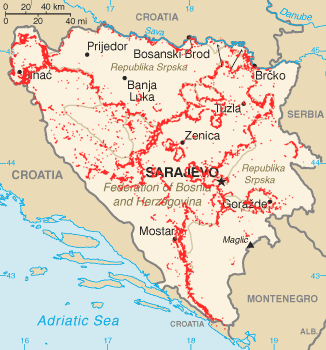Land mine contamination in Bosnia and Herzegovina on:
[Wikipedia]
[Google]
[Amazon]
 Land mine contamination in
Land mine contamination in

 Bosnia and Herzegovina's land mine contamination stems exclusively from the 1992–95 war in the country. By 1996, some two million land mines and unexploded munitions littered Bosnia. By September 2013, land mines and unexploded munitions remained scattered in 28,699 locations. A total of 1,230.70 km2 (2.4% of the country's territory) was mined. In May 2014, extensive landslides and the worst flooding since the 19th century unearthed landmines, prompting authorities to send in de-mining workers to locate and deactivate mines that were threatening residential areas.
Land mine clearing is done by various government agencies and NGOs as well as some
Bosnia and Herzegovina's land mine contamination stems exclusively from the 1992–95 war in the country. By 1996, some two million land mines and unexploded munitions littered Bosnia. By September 2013, land mines and unexploded munitions remained scattered in 28,699 locations. A total of 1,230.70 km2 (2.4% of the country's territory) was mined. In May 2014, extensive landslides and the worst flooding since the 19th century unearthed landmines, prompting authorities to send in de-mining workers to locate and deactivate mines that were threatening residential areas.
Land mine clearing is done by various government agencies and NGOs as well as some
Bosnia and Herzegovina Mine Action Centre
{{Land mines by region or country
 Land mine contamination in
Land mine contamination in Bosnia and Herzegovina
Bosnia and Herzegovina ( sh, / , ), abbreviated BiH () or B&H, sometimes called Bosnia–Herzegovina and often known informally as Bosnia, is a country at the crossroads of south and southeast Europe, located in the Balkans. Bosnia and ...
is a serious aftereffect of the Bosnian War
The Bosnian War ( sh, Rat u Bosni i Hercegovini / Рат у Босни и Херцеговини) was an international armed conflict that took place in Bosnia and Herzegovina between 1992 and 1995. The war is commonly seen as having started ...
, which took place from 1992 until 1995. During this time period, all 3 conflicting factions (ARBiH
The Army of the Republic of Bosnia and Herzegovina ( bs, Armija Republike Bosne i Hercegovine or ARBiH), often referred to as Bosnian Army, was the military force of the Republic of Bosnia and Herzegovina. It was established by the government of ...
, HVO, and VRS) planted land mine
A land mine is an explosive device concealed under or on the ground and designed to destroy or disable enemy targets, ranging from combatants to vehicles and tanks, as they pass over or near it. Such a device is typically detonated automati ...
s near the current-day political entity borders. As a result, the country has had the most severe land mine problems in the world.
Land mine situation

 Bosnia and Herzegovina's land mine contamination stems exclusively from the 1992–95 war in the country. By 1996, some two million land mines and unexploded munitions littered Bosnia. By September 2013, land mines and unexploded munitions remained scattered in 28,699 locations. A total of 1,230.70 km2 (2.4% of the country's territory) was mined. In May 2014, extensive landslides and the worst flooding since the 19th century unearthed landmines, prompting authorities to send in de-mining workers to locate and deactivate mines that were threatening residential areas.
Land mine clearing is done by various government agencies and NGOs as well as some
Bosnia and Herzegovina's land mine contamination stems exclusively from the 1992–95 war in the country. By 1996, some two million land mines and unexploded munitions littered Bosnia. By September 2013, land mines and unexploded munitions remained scattered in 28,699 locations. A total of 1,230.70 km2 (2.4% of the country's territory) was mined. In May 2014, extensive landslides and the worst flooding since the 19th century unearthed landmines, prompting authorities to send in de-mining workers to locate and deactivate mines that were threatening residential areas.
Land mine clearing is done by various government agencies and NGOs as well as some NATO
The North Atlantic Treaty Organization (NATO, ; french: Organisation du traité de l'Atlantique nord, ), also called the North Atlantic Alliance, is an intergovernmental military alliance between 30 member states – 28 European and two N ...
military units. Between 1996 and 2017, more than 3,000 square kilometres have been cleared of mines. Bosnia and Herzegovina's strategic vision in 2008 was to clear all land mines by the year 2019. In April 2017, experts thought it would take at least five years longer, citing a lack of funds as the primary hurdle. 80,000 mines were estimated to be yet uncleared, located across 2.2% (1,125 km2) of the Bosnian territory.
On 4 April, International Mine Awareness Day, the government, the UN and a number of other international and local NGOs inform citizens about the dangers of land mines and the efforts to clear them.
Land mine casualties
From 1992 through 2008, 5,005 people were killed or injured by land mines or unexploded munitions. Wartime casualties stood at 3,339 killed and injured. Peacetime casualties, from 1996 through 2008 number 1,666 of which 486 persons were fatalities. From 1996 to 2017, more than 1,750 people were injured, at least 612 of them fatalities.References
External links
Bosnia and Herzegovina Mine Action Centre
{{Land mines by region or country
Bosnia
Bosnia and Herzegovina ( sh, / , ), abbreviated BiH () or B&H, sometimes called Bosnia–Herzegovina and Pars pro toto#Geography, often known informally as Bosnia, is a country at the crossroads of Southern Europe, south and southeast Euro ...
Bosnian War